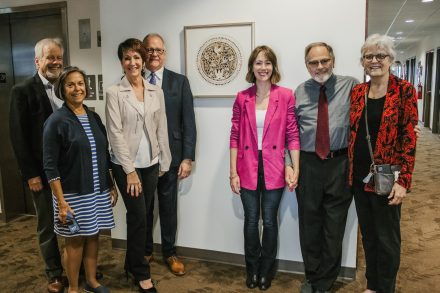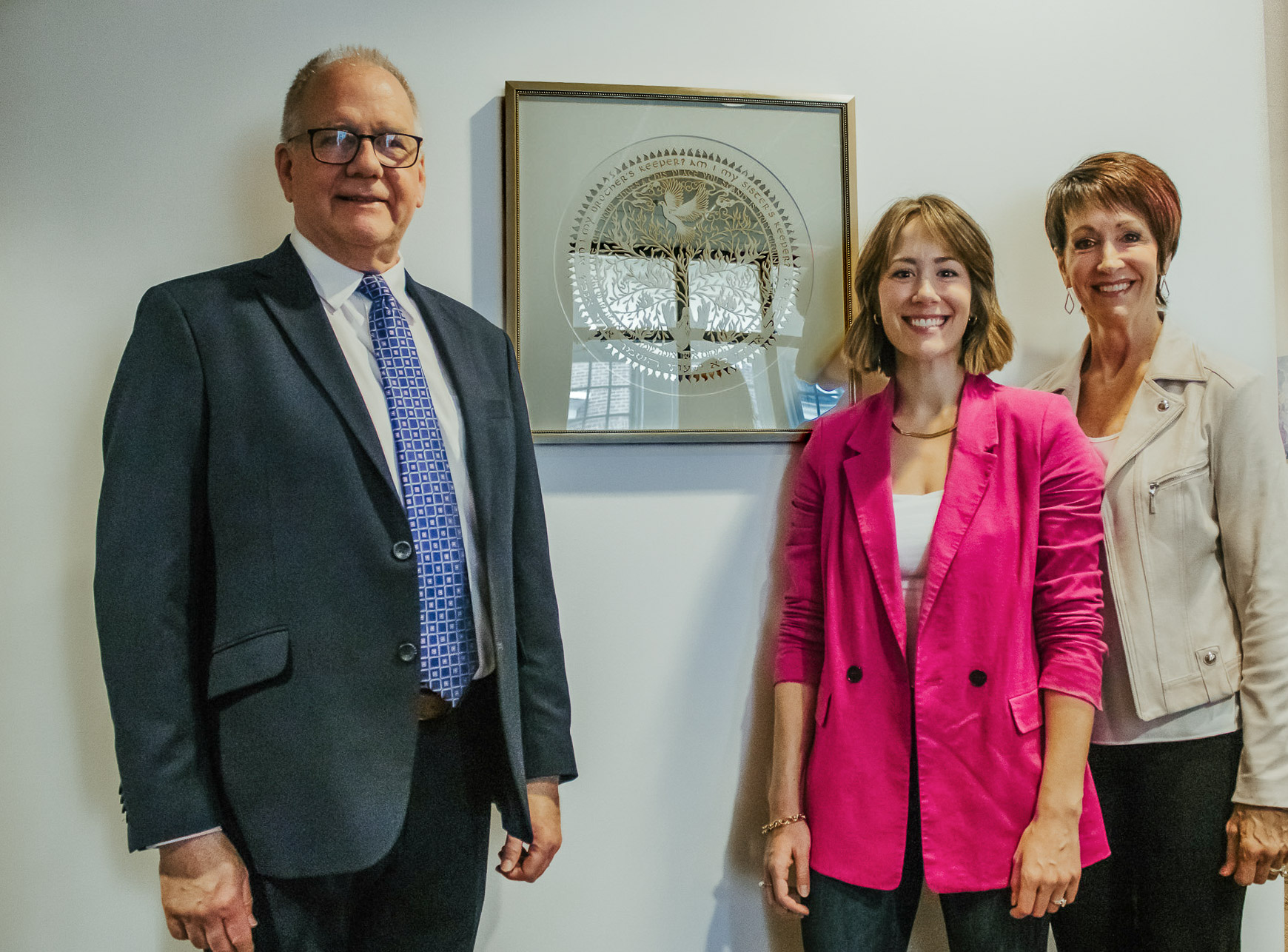The Holland Family makes donation of limited-edition Diane Palley papercut to the Truitt Center for Religious and Spiritual Life.
“Elon is more than an institution,” said Kevin Holland ’78 P’12 P’14 to the guests assembled on the second floor of the Numen Lumen Pavilion. “Elon is a feeling. It’s a passion, it’s our community, and it’s our family.”
On Monday, March 4, that inspiring vision was the focus of the dedication of “Standing in Light and Shadow: Seeing Ourselves Through Image and Text,” a limited-edition Diane Palley papercut that now hangs in Numen Lumen Pavilion.
The Holland family — Kevin Holland ’78 P’12 P’14 and Karen Holland ’87 P’12 P’14 — gifted the work of art to the Truitt Center for Religious and Spiritual Life to honor the lasting impact and the work of Chaplain Emeritus Richard McBride and Professor Emeritus and Distinguished University Professor Jeffrey Pugh.
The constellation of relationships that connect the Holland family to the university exemplify the overarching message of this piece – to look out for other members of the campus community, and to build the strong and meaningful relationships that characterize the Elon experience.
The central motif of the work is the burning bush, which emerges out of two hands in the shape of a human heart: “The challenge is to find the holy place of compassion in the midst of life and tragedy, and in our own hearts—and then to take appropriate action,” according to a statement from artist Diane Palley.
The entire piece, created by traditional Jewish papercutting methods, is mounted in

front of colored mirrors. The viewers of the work are invited to see themselves in the images and the text, and to experience the piece as active participants.
“The flames are transformed into a bird—a dove, the universal symbol of spirit and redemption,” Palley explains. “The eye of the bird is our own eye looking through the fragile cut paper to the mirror behind. The verse around this circle (Genesis 4:9) is the central message of the piece, extended to include our sisters as well as our brothers: Where is Abel your brother? I do not know. Am I my brother’s keeper?”
Kevin Holland referred to that biblical question during the March 4 ceremony. “If there is any community that can answer that question ‘Am I my brother’s keeper’ it is Elon.” As a relationship-rich institution, Elon encourages students, faculty, staff and families to connect in ways that fuel personal and professional growth and encourage reflection on meaning and purpose.
The Holland family connection to Elon not only spans generations but also different kinds of connections. Kevin Holland attended Elon and he was a member of the faculty from 1983 to 1987. Karen is an alumna, and the couple is the proud parents of two alumni, Ashley Holland ’12 and Sarah Holland ‘14.

And of course, the Hollands are also connected through relationships outside the immediate family. Pugh was Sarah Holland’s research mentor as an Elon Scholar, and their work together inspired them both.
As Pugh shared during the dedication, meaningful mentoring relationships have a tremendous impact. “When you learn that your work made a difference to someone, that is the greatest possible achievement,” Pugh said.
And the Holland family’s relationship with McBride went one step further, from professional relationships to the personal. Not only has McBride become a close family friend, he performed the wedding ceremony for Karen and Kevin Holland in 1986 and he married Sarah and her husband in June 2022.
The Diane Palley papercut is a reflection of these relationships, and these values, for the Holland family. Karen and Kevin hope that every time visitors to the Numen Lumen Pavilion walk up the stairs to the second floor, they take a moment to pause in front of the work, to see their reflection, and to think about themselves, their community, and the world.
As the artist wrote, “A papercut is uniquely suited to this journey; our reflection creates the background and contrast that craft the images. We are invited to consider ourselves as both victim and perpetrator, as survivor and hero.”



